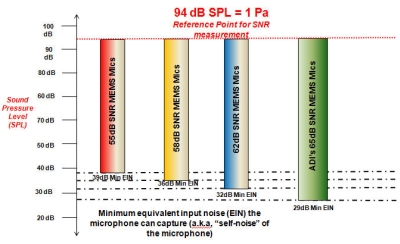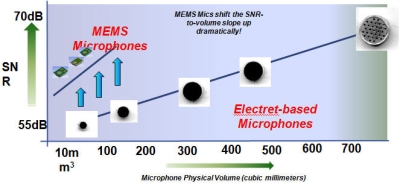Low self noise: The first step to high-performance MEMS microphone applications
更低噪声的麦克风的应用场景
Jerad Lewis, Applications Engineer, and Paul Schreier, Marketing Manager, Analog
Devices, Inc.
11/28/2012 10:23 AM EST
Microelectromechanical system (MEMS) microphones offer plenty of advantages
typical of MEMS devices, including tiny size, low power usage, and consistent
performance over time and temperature. But the audio specifications of these
microphones have not been sufficient for certain designs - including ones where
you need to capture sound from a distance or use multiple microphones. Now high-performance
MEMS mics are changing what is possible, and many acoustics experts would say
self noise is the first specification to consider. MEMS麦克风的优势,但是在某些高端应用的时候比如远距离采集和阵列麦克风时其性能也不是最佳,这时音频工程师首选的指标就是自有噪声
Self noise - what you need to know 什么是自有噪声?
Any microphone produces some level of noise: through its electronics, its transducer
element, its housing. This inherent noise is known as self noise. It’s a familiar
sound to anyone using a cell phone. For example, self noise contributes to the
hiss you hear when your mobile phone is on and nobody is talking. 麦克风的噪声由电子噪声,传感器,和封装噪声组成,总称自有噪声,对于任何使用手机的人都很熟悉的声音,就是手机在通话的时候没有任何人说话的时候的嘶嘶声音。
For an electronics designer, microphone self noise is an ever-present constraint.
The idea is to have the mic present as much signal as possible to the rest of
the signal chain. But part of the signal you capture from the audio source will
fall below the microphone’s inherent self noise, which is also called its noise
floor.对于一个电子工程师,麦克风的自有噪声是一个普遍存在的一个瓶颈,想要麦克风的信号足够多,然后传递给后端的电路,但是对于音源采集的声音要低于麦克风的自有噪声,也叫做底噪。
The noisier a microphone is, the less signal you have available. A lower noise
microphone will give you room to isolate the sound you want from the noise that
you don’t. Then your processor - DSP or codec - has more signal to work with.
As a result, the output from the signal chain sounds much better when you start
with a quieter microphone. 麦克风的底噪越高,你获得的信号就越少。用低噪声的麦克风来隔离不想要的噪声信号成为可能,然后你的处理器或者Codec-就有了更多的信号来处理,最后,信号链的输出的声音就更加丰富和饱满。
A high signal-to-noise ratio (more about SNR in the next section) indicates
a quiet microphone, and a lower SNR specification tells you the microphone has
more self noise. 高信噪比的麦克风就是指更安静的麦克风,低信噪比的麦克风意味着自有噪声更高。
While a high SNR is always useful, you don’t depend on it as much when your
audio source is very close to the microphone. There is usually enough signal
for these near-field applications. In far-field applications where the microphone
isn’t positioned next to the sound source, a noisy mic with a low SNR leaves
you with a poor or unintelligible signal. 高信噪比的麦克风一直都有用,你不需要依赖你的音源需要非常靠近麦克风。在近端应用有足够的信号。在远场应用中,麦克风没有直接对着声源,底噪高的麦克风(低信噪比)将给你很差或者模糊的录制信号。
What the specs tell you 此指标提供了什么?
The self noise, or noise floor, of the microphone does a lot to define the
quality of audio you are able to capture and pass onto the signal chain. Signal-to-noise
ratio (SNR) and equivalent input noise (EIN) are two specifications that describe
where that noise floor is.
And as we will soon discuss in more detail, the self noise of MEMS microphones
has reached a level far better than past generations of the technology (Figure
1). 
Figure 1: The self noise of MEMS microphones has reached a level far better
than past generations of the technology.
Signal-to-noise ratio (SNR)
SNR is the ratio of a reference signal to the noise floor of the microphone.
A microphone’s SNR is the difference between its inherent self noise level and
a standard reference pressure, specifically 94 dB SPL (1 Pa) at 1 kHz. 信噪比=94-底噪
You will typically see this specification presented as an A-weighted value (dBA)
with a 20 kHz bandwidth. A-weighting means the SNR being presented includes
a correction factor that corresponds to the human ear’s sensitivity to sound
at different frequencies.
When you compare the SNR of different microphones, make sure they are based
on the same weighting and bandwidth. A comparison will not be accurate if the
measurements don’t use the same weighting and bandwidth.1
Equivalent input noise (EIN)
Equivalent input noise is the output noise level of the microphone represented
as a theoretical acoustic noise source placed at the microphone’s input. The
unit of measurement is sound pressure level, measured in decibels (dB SPL).
SPLs less than the EIN level are below the noise floor of the microphone.
You can determine the EIN directly from the microphone’s SNR specification:2
EIN = 94 dB - SNR
MEMS microphones double their SNR performance
The MEMS industry’s earlier generations of microphones offered an SNR around
58 to 60 dB, which did not equal the acoustic performance you could get from
electret condenser microphones (ECMs). The situation is changing now that leading
manufacturers are making dramatic improvements to the performance of MEMS microphones.
早期MEMS麦克风的信噪比在58-60dB之间.
The ultra-low noise Analog Devices ADMP504 and ADMP521 MEMS microphones have
lowered the noise floor of earlier MEMS mics by more than 2x. The ADMP504 and
ADMP521 are the first MEMS microphones to reach the level of 65 dBA SNR (29
dBA EIN).
An SNR spec of 65 dBA is good even for an electret microphone, but ECMs tend
to be much larger than MEMS mics with comparable SNRs. As the size of an ECM
gets smaller, its SNR drops quickly (Figure 2). ECMs also don’t offer the other
advantages that MEMS mics do, such as a consistent response to sound across
all operating temperatures.驻极体麦克风的65dB信噪比物理尺寸变得很大,可靠性也很差比如温度灵敏度指标

Figure 2: As the size of an electret condenser microphone gets smaller, its
SNR drops quickly.驻极体电容式麦克风的尺寸越小,其信噪比越低
Capturing sound at a distance single mic 一个单麦克风就可以实现远距离录音
Where can you take advantage of the SNR of a very high performance MEMS microphone?
Though almost any application would benefit, you can now consider these microphones
where you might not have been able to before.
In applications such as video conferencing, professional audio, and industrial
systems, the source of the sound is often not next to the mic. Far-field applications
like these are good examples of where a low-noise MEMS microphone will be beneficial.
视频会议, 专业音频, 工业系统都可以受益于高信噪比,因为它们的麦克风距离音源都很远
One specific example is video calling (think Skype) with webcams and tablet
computers. Now MEMS microphones can enable high-definition audio capture for
these products, and MEMS mic packages are compact enough to place inside even
the smallest consumer electronics devices. 比如Skype带摄像头通信和平板电脑,MEMS麦克风可以高保真语音采集,且有尺寸优势
Using MEMS microphones as acoustic sensors is another possibility. In industrial
equipment designs, positioning a microphone inside the housing of a machine
isn’t always practical. However, you sacrifice a lot of signal when the microphone
has to pick up sound transmitted through a solid barrier. 工业系统中放置声波传感器在产品壳子里面,通过实体的障碍来传输音频,牺牲了有用信号
A microphone with low self noise will be more capable of acquiring an adequate
signal. For instance, a microphone in a flow control application could identify
production problems by listening for material flowing through a tube.低噪声的麦克风获取更多有用信号,比如流体管道监听,可以检测出生产问题
Multiple microphone applications 多麦克风应用
A low noise floor is also critical for any multi-microphone beamforming algorithm.
Beamforming algorithms often result in a higher system noise level, as compared
with a single microphone in the array. Therefore it becomes critical for each
mic in the array to have a high SNR.波束成形通常产生更高的系统噪声
Because beamforming increases the directionality of a microphone array, these
arrays are popular in videoconferencing systems. That includes stationary videoconference
equipment for corporate conference rooms, as well as the TV set-top boxes people
use to make video calls from their living rooms. 视频会议
Multi-microphone beamforming is also used in security applications. Security
and surveillance equipment is normally mounted in a fixed spot, and of course,
not all suspicious activity will take place within the camera’s field of view.
With low-noise MEMS microphones, security cameras on homes and commercial buildings
can use audio to detect which direction a sound is coming from and point the
camera lens at that target.安防监控领域,声音测向,伺服摄像头
Consider how low the microphone can go 麦克风信噪比到底能做多高
Though you will ultimately consider more than one aspect of a microphone’s performance,
a low noise floor is a make-or-break spec for challenging audio capture applications.
So if you needed high SNR in the past, you would probably have had to choose
an electret mic. These days your options are no longer limited to traditional
microphone technology. 以前对高信噪比需要高档ECM,现在就不需要再局限于ECM了
MEMS microphones are ready for many new high performance applications now that
some mics offer more than double the SNR of their predecessors. The maturing
of MEMS microphone technology has added ultra-low noise to the compact size,
reflow-compatible packaging, and everything else you expect from modern MEMS
microphones.
Footnotes 脚注
1,2 For more about MEMS microphone specifications, see Microphone Specifications
Explained by Jerad Lewis (Analog Devices Application Note AN-1112).
About the authors
Jerad Lewis is a MEMS microphone applications engineer at Analog Devices. He
joined the company in 2001 after getting his BSEE from Penn State University.
Since then, he's supported different audio ICs, such as converters, SigmaDSPs,
and MEMS microphones.
Paul Schreier is product marketing manager for MEMS Microphones in Analog Devices'
MEMS and Sensor Technology Group and holds degrees in Computer Engineering and
Finance from the University of Nebraska and an MBA from Boston College. Prior
to joining ADI, Mr. Schreier held various sales and marketing positions at National
Semiconductor, Texas Instruments and NXP.
此文章链接:
http://www.eetimes.com/design/audio-design/4402239/Low-self-noise--The-first-step-to-high-performance-MEMS-microphone-applications
Vesper硅麦克风高信噪比产品线介绍
高信噪比压电硅麦克风样品&报价&技术&参考设计联系0755-82565851 邮件dwin100@dwintech.com 手机156-2521-4151
首页home 产品product 新品发布news 参考设计ref.d 联系contact 应用笔记app note
 D-Win Technology(HongKong) Co.,Ltd 深圳市南频科技有限公司 回首页
D-Win Technology(HongKong) Co.,Ltd 深圳市南频科技有限公司 回首页


